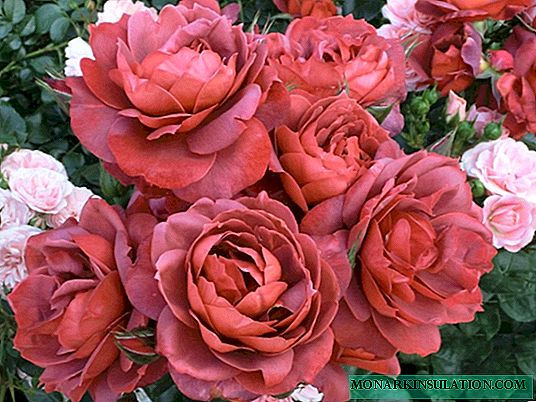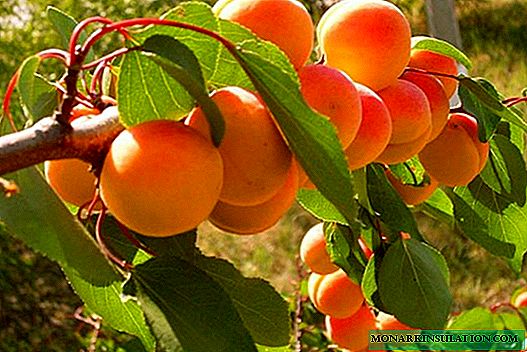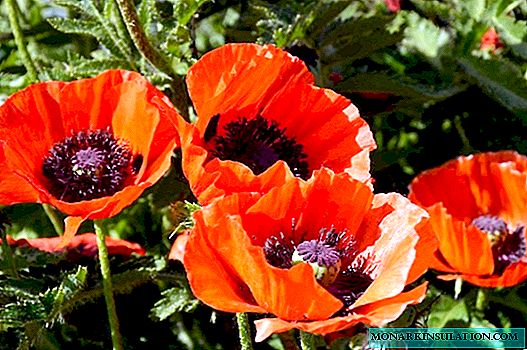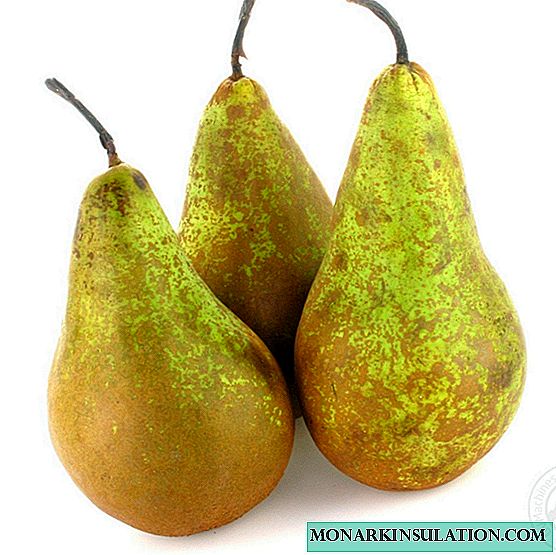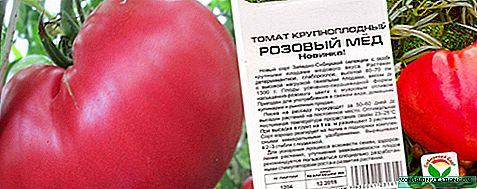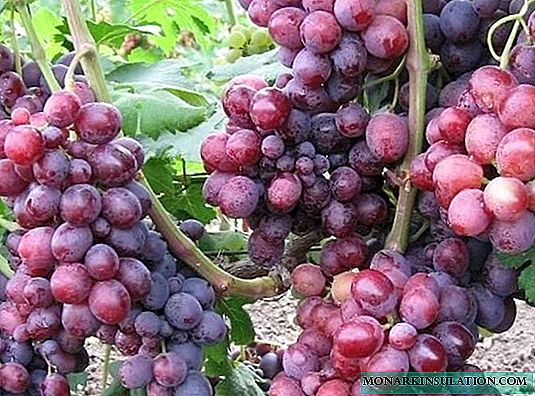
Yaroslavna is a fairly popular sweet cherry variety in the southern regions of the European part of Russia and Ukraine. Before planting cherries, the gardener needs to know the characteristics of the variety, its strengths and weaknesses, as well as the intricacies of cultivation and care.
Description varieties of cherries Yaroslavna
The sweet cherry variety Yaroslavna was selected from the yellow Drogany seedlings grown in the environment of the Melitopol varieties and pollinated by them. The variety was listed in the State Register for the North Caucasus Region in 1997. The tree is medium-tall (tall according to the description of the All-Russian Research Institute for Fruit Crop Breeding), with a round, medium-thickened crown.

Crohn's crown Yaroslavna - round, medium thickened
Ripening period is early (according to VNIISPK - medium early). Usually the berries ripen a few days after the variety Valery Chkalov. Yaroslavna blooms in early May with small white flowers. The variety is self-sterile, therefore pollinators are necessary. The best ones are:
- Valery Chkalov;
- Valeria;
- Donchanka;
- Donetsk beauty.
Somewhat worse, but acceptable:
- Aelita;
- Drogana yellow;
- Donetsk coal;
- Melitopol early;
- Ethics.
The plant begins to bear fruit 4-5 years after planting. Productivity is high; at the age of 10, up to 100 kg of berries are harvested from one tree.
Wood and flower buds have increased winter hardiness. The tree is drought-resistant, has high immunity to coccomycosis and medium to other fungal diseases.
The berries are round-ovoid in dark red color. The average weight is 6.7 g (according to VNIISPK - 7-8 g, and some sources report berries of Yaroslavna weighing up to 12 g). The pulp is juicy, sweet, medium-dense. The taste is pleasant, dessert. The rating of tasters is 4.5 points out of 5. The variety belongs to the semi-bigroro group, which provides it with good resistance to cracking of berries and high transportability. The purpose of the fruit is universal.
All cherries are divided into two groups: bigarro and gini. The former have a dense, crisp pulp, the berries keep their shape and do not soften in compotes. The second have juicy and tender flesh, short shelf life, poor portability. They are not suitable for processing.

Berries of cherry Yaroslavna have a rounded ovoid shape
Advantages and disadvantages
The main advantages of the variety:
- early maturity;
- high and regular productivity;
- winter hardiness;
- drought tolerance;
- early ripening;
- excellent taste of berries;
- universality of use;
- good transportability;
- resistance to cracking;
- resistance to coccomycosis.
The disadvantages are significantly less:
- self-infertility;
- lack of immunity to fungal diseases;
- high tree growth in the absence of formation.
Planting cherries
The process of planting sweet cherry Yaroslavna is subject to the general rules for trees of this crop.
Brief step-by-step instruction:
- The choice of place. It must meet the following requirements:
- Good illumination (slight penumbra is allowed).
- Protection from cold winds and drafts.
- Groundwater level - not higher than 3 m.
- No stagnation of moisture.
- Soils are loamy, sandy loam, chernozems.
- The acidity of the soil is close to neutral.
- Landing pattern - 3.5-4 m between rows and 3-3.5 m interval in a row.
- Landing dates. In the southern regions, you can plant a plant in the fall (October - mid-November), and in early spring before the buds swell. In the northern regions, spring planting is preferable.
- The preparation of the pit is made 2-3 weeks before planting. If it is scheduled for spring, then it is better to prepare a pit in the fall. Do it like this:
- Dig a hole to a depth of 80 cm with a diameter of 80-100 cm.
- A layer of crushed stone (expanded clay, broken brick, etc.) is laid at the bottom to ensure drainage.

A drainage layer is laid at the bottom of the landing pit.
- The pit is filled to the brim with nutrient soil. You can use black earth, organic matter (humus, compost), peat and sand in equal proportions.
- Before planting, the roots of the seedling are soaked for several hours in water.
- In the center of the pit, they dig a hole of such a size that the roots of the seedling fit into it, and form a small mound.
- The seedling is lowered into the hole, spreading the roots along the slopes of the mound.
- They fill the hole with soil, ramming it in layers. In this case, the root neck should not be buried - it is better to place it 3-5 cm above the ground.

The root neck of the seedling should not be buried when planting
- Around the tree form a trunk circle.
- The seedling is abundantly watered several times until the water is completely absorbed (this ensures a tight fit of the soil to the roots).
- The soil is mulched to reduce moisture evaporation, prevent the formation of soil crust and provide air access to the roots.

After watering, it is advisable to mulch the soil
- The seedling is cut to a height of 0.85-0.9 m, and all branches (if any) are shortened by 50%.
Features of cultivation and subtleties of care
Sweet cherry Yaroslavna is quite unpretentious for leaving. Like any tree, it needs watering, top dressing and pruning. In general, all these events do not have any varietal features, so we will not dwell on them. In more detail we will touch cropping. Since the variety tree has a large growth force, a suitable form for the crown is sparse-tiered. The rules of this formation:
- The first step was taken during landing - the central conductor was trimmed.
- In the early spring of the next year after planting, the first tier of the tree is formed. For this:
- On the trunk, choose 2-3 good shoots (they will become skeletal branches) that meet the following conditions:
- The lower shoot is located at a distance of 30-40 cm from the ground.
- Shoots grow in different directions.
- The distance between them is 10-15 cm.
- All buds below the first shoot selected are blind.
- Branches, in addition to those selected as skeletal, are cut "into a ring".
- Left shoots are shortened by 30-40%.
- The central conductor is cut at a height of 10-15 cm above the base of the upper branch.
- On the trunk, choose 2-3 good shoots (they will become skeletal branches) that meet the following conditions:
- After 1-2 years (also in early spring), the second tier of skeletal branches is formed in a similar way.
- After another 1-2 years, a third tier is formed - usually it consists of one branch.
- The central conductor is cut off over the base of the upper branch.

Cherry Yaroslavna is cut so that a sparse-tier crown shape is obtained
All other trimmings (sanitary, thinning, rejuvenation) are carried out according to the usual rules.
Video: how to care for cherries
Pest and Disease Control
This is not to say that Yaroslavna often suffers from diseases and the invasion of pests. If the gardener is experienced, then he promptly and regularly performs simple preventive measures that minimize the appearance of these problems.
Table: preventive measures against diseases and pests of cherries
| The timing | activity | Achieved effect |
| October November | After leaf fall, fallen leaves are collected and burned. | Destruction of spores of fungi and wintering pests. |
| Identify possible damage to the cortex and, if available, conduct treatment. To do this, they are cut into healthy wood, after which they are treated with a 5% solution of copper sulfate, and then a protective layer of putty or garden varnish is applied. | Prevention of black and conventional cancer, gummosis, cytosporosis. | |
| Trunks and branches are bleached with a solution of lime or garden paints. | Prevention of sunburn and frost. | |
| November December | Dig the soil around the tree to the depth of the bayonet of a shovel, turning over the layers of earth. | Pests wintering in the soil are removed to the surface, as a result of which they die from frost. |
| February March | The shoots and the trunk are sprayed with universal pesticides (DNOC, Nitrafen, 5% solution of copper sulfate or Bordeaux fluid). | Prevention of fungal diseases and pests. |
| End of April - May | Three sprayings are carried out with a tank mixture of Horus and Decis:
|
Troubles threatening sweet cherry Yaroslavna
If for some reason the prevention was not carried out or did not give the desired results, then some fungal diseases and pest attacks are not excluded:
- Moniliosis. In the spring, the ailment can be detected by characteristic signs - the affected leaves, flowers and shoots look like scorched by fire. Having found such symptoms, diseased shoots should be cut, while capturing a healthy part 10-20 cm long. After this, the cherries are sprayed with fungicides (Horus, Abiga-Peak, Skor).

In the summer, moniliosis affects the berries of cherries and cherries, which are covered with spots of gray rot
- Kleasterosporiosis (perforated spotting). Small holes with a reddish-brown rim are formed on the leaf plates. If untreated, the leaves may dry out and fall prematurely, cracks, and gum-dropping. Treatment consists in removing affected leaves and treating with fungicides.

A sign of infection with kleasterosporiosis is the formation on the leaves of holes with a diameter of 5-7 mm
- Cherry fly. Early varieties of cherries are less likely to become infected with the larvae of the cherry fly, as they usually creep out of the eggs after harvest. The problem can only be prevented by the implementation of preventive measures. 2-3 treatments (one before flowering, the rest after flowering with an interval of 1-1.5 weeks) by insecticides significantly reduce the risk of damage. Most often used Decis, Fitoverm, Spark.
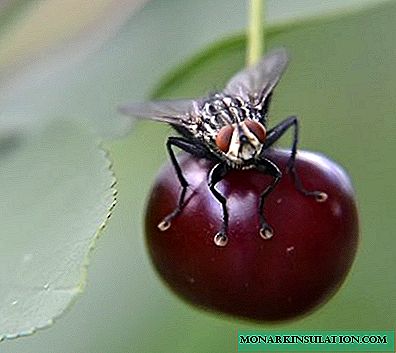
Larvae of a cherry fly feed on berries of a cherry
- Cherry Weevil. In early spring, beetles begin to eat young leaves, buds, shoots. After mating, the females lay their eggs in buds, for which they are pre-cut. In the morning at an air temperature of 5-7aboutC weevils sit on branches in a daze. You can spread the film under the cherry and shake them off the branches. At the same time, trees are sprayed with insecticides.

Cherry weevil larvae feed on flesh of berries and kernel kernels
Reviews
In the conditions of the Kharkov region (with a favorable wintering of sweet cherries), it is Yaroslavna that is characterized by a stable yield of early-ripening dark red fruits. Perhaps because for her good pollinators are Donchanka, Donetsk Beauty, Valery Chkalov and Valeria - varieties that are quite common in Ukrainian gardens. Winter hardiness - at the level of yellow drogans, high resistance to fruit cracking. Ordinary amateur gardeners are fooled by the ripening period - mid-early (and most want early!).
MAR, Kharkov
//forum.vinograd.info/showthread.php?t=11173&page=3
This year, it began to ripen on June 6-7, earlier than in the past. The berry is whole and very tasty. For comparison, V. Chkalov is completely cracked, although he matured a week earlier.
* iya *, Kiev
//forum.vinograd.info/showthread.php?t=11173&page=3
Of the 10 varieties that I already bear fruit, Yaroslavna is the best in terms of a set of characteristics. The fruits are very similar to V. Chkalov, but tastier. It is even grown by the Poles. Vaccinated on the overgrown cherries of Vladimir 2 years ago. With a growth of 1.5 m, the crop amounted to about 2.5 kg. When the birds started to peck, he covered it with a tulle curtain. It helped. They did not give ripen, ate.
ivanlevin, Belgorod region
//forum.vinograd.info/showthread.php?t=11173
I really like Yaroslavna, a very resistant variety to cracking, to coccomycosis and fruit rot, and very winter-hardy. heat resistant and drought resistant. It may be slightly smaller, but the taste, when fully ripened, is excellent.
sweet cherry, Donetsk
//forum.vinograd.info/showthread.php?t=351&page=199
The voluminous list of the advantages of the variety of sweet cherry Yaroslavna makes it attractive for growing in private households. It will also be interesting to farmers due to the good transportability of berries, excellent quality of canned products, and unpretentiousness of the tree.









